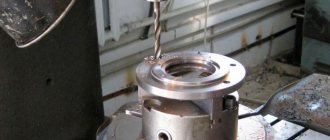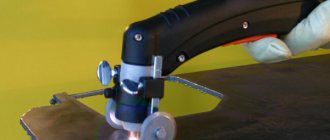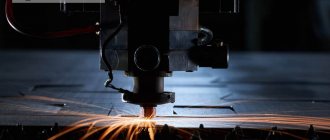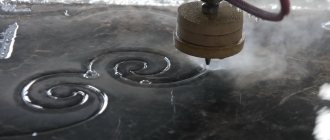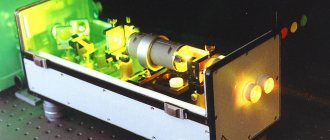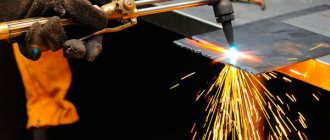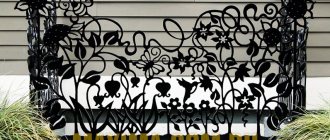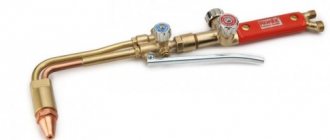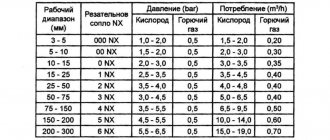Cutting metal with hand scissors
TO
category:
Metal cutting
Cutting metal with hand scissors
Next: Cutting metal with a hacksaw
Manual musical instruments are used for cutting steel sheets with a thickness of 0.5 - 1.0 mm and non-ferrous metals up to 1.5 mm. Hand scissors are made with straight and curved cutting blades,
According to the location of the cutting edge of the blade, hand scissors are divided into right and left.
Rice. 1. Elements of scissors
Right-handed scissors are those in which the bevel on the cutting part of each half is on the right side. Using right scissors, cut along the left edge of the product in a clockwise direction.
Left-handed scissors are those in which the bevel on the cutting part of each half is located on the left side. These scissors are used to cut along the right edge of the product counterclockwise.
When cutting a sheet with right-handed scissors, a mark is always visible on the metal being cut. When working with left-handed scissors, in order to see the mark, you have to bend the cut metal with your left hand, passing it over your right hand, which is very inconvenient. Therefore, sheet metal is cut in a straight line and along a curve (circle, rounding) without sharp turns with right-handed scissors.
The scissors are held in the right hand, grasping the handles with four fingers and pressing them to the palm; The little finger is placed between the handles of the scissors.
The clenched index, ring and middle fingers unclench, straighten the little finger and, with its effort, move the lower handle of the scissors to the required angle. Holding the sheet with your left hand (Fig. 2, b), feed it between the cutting edges, directing the upper blade exactly in the middle of the marking line, which should be visible when cutting. Then, squeezing the handle with all fingers of the right hand, except the little finger, they cut.
In Fig. 2, c, d shows techniques for working with scissors.
For straight cutting of metal of small thickness, hand scissors are used, one handle of which is clamped in a vice.
Chair staves differ from manual ones in their larger sizes and are used when cutting sheet metal up to 3 mm thick. The lower handle is firmly clamped in a bench vice or fastened (hammered) onto a table or other rigid base. For cutting sheet steel up to 3 mm thick, chair scissors with a stationary fastening are used (Fig. 3, c).
Chair shears are low-productive and require significant effort when working, so they are not used for cutting large batches of sheet metal.
Manual small-sized power music books. Innovator A. N. Vasiliev created small-sized power shears for cutting sheet steel up to 2.5 mm thick, rods, bolts (studs) with a diameter up to 8 mm. The dimensions of these scissors do not exceed the dimensions of standard hand scissors (Fig. 4). For cutting, the handle is secured in a vice, and the handle (working) is activated. The working handle is a system of two levers connected in series. The first lever, on one arm of which the knife is fixed, is connected to the handle with a screw.
Rice. 2. Working with scissors: a - position of the hand on the handle when cutting with scissors, b - with straight blades, c - with curved blades, d - cutting out the internal curved contour
Rice. 3. Scissors: a - chair scissors, fixed in a vice, b - hand scissors, fixed in a vice, c - chair scissors on a wooden base
Rice. 4. Small-sized power shears
Rice. 5. Lever shears
Rice. 6. Flying scissors
The second arm of the lever, which is the handle of ordinary scissors, is shortened and ends with a hinge, or the scissors handle itself. The end hinge of the handle is connected to the handle using a double-hinged link. This lever system approximately doubles the cutting force compared to conventional scissors of the same size. The scissor blades are replaceable and attached to the levers with hidden rivets.
These scissors also have a device for cutting rods with a diameter of up to 8 mm. The device has discs with holes mounted on scissor arms and is a regular scissors, but with specially shaped knives (hardened bushings). These knives are replaceable and are inserted into the disk socket. For cutting bolts (piles). in the bushings of one of the disks there is a groove (several threads), which protects the threads of the bolts from being crushed during cutting.
Small-sized power shears provide good cutting quality.
Lever shears (Fig. 5) are used for cutting sheet steel up to 4 mm thick, aluminum and brass up to 6 mm. The upper hinged knife is driven by a lever. The lower knife is stationary.
The knives are made from U8 steel and hardened to a hardness of HR.C 52 - 60. The sharpening angles of the cutting edges are 75 - 85°.
Before work, check whether the rubbing parts are lubricated, whether the lever moves smoothly, and whether there is a gap between the cutting edges.
When cutting metal, grab the handle of the lever with your right hand and smoothly move it to the upper position, while the upper knife 3 moves upward. Then the sheet is laid so that the left hand holds it in a horizontal position, and the cut line is in the field of view and coincides with the blade of the upper knife. By moving the hand, lower the lever with the knife down until part of the metal is cut through, after which the lever is moved to the upper position. Next, slightly lift sheet 4 with your left hand, move it along the line along the cutting edge of the upper knife and repeat the cutting technique until it is completely cut. The scissors provide a cut without dents, cuts along the edge and sufficient accuracy.
Fly shears are widely used for cutting sheet metal with a thickness of 1.5 - 2.5 mm with a tensile strength of 450 - 500 MPa (45 - 50 kgf/mm2) (steel, duralumin, etc.). These scissors cut metal of considerable length. Lever shears have a cast iron frame and table. A lower stationary knife is built into the table, and an upper movable knife with a curved cutting edge is fixed in a knife holder. The upper movable knife has a counterweight that balances the knife holder with the knife.
The size of the workpieces to be cut is pre-marked or limited by an adjustable stop, for which the stop is first set at the required distance from the cutting edge of the lower stationary knife. During cutting, the sheet is tightly pressed with its side edge against the stop, and with the other edge against the spring stop. After this, by turning the handle away from you, the sheet is pressed tightly from above with a clamping bar and, lowering the upper nose with knife holder 6, the workpiece is cut.
When lowered, the knife holder rests against a spring stop. Rearrangement of the stop is carried out using the handle.
Shears with inclined knives (guillotine) allow you to cut sheet metal up to 32 mm thick, sheets with dimensions of 1000 - 3200 mm, less often strip products, as well as sheet non-metallic materials.
Is it possible to cut sheets of metal tiles with a grinder?
How to cut metal tiles during installation without damage is determined by the manufacturer himself. The brand informs users about this in the documentation included with the sheets. Using recommended devices reduces the risk of material damage and reduction in its quality.
Many people mistakenly believe that cutting canvas with a grinder is a far-sighted decision. But such adjustment of parameters does not lead to a high-quality result; the structure of the material is destroyed. The layered structure is subjected to excessive heating from the operation of the tool, therefore all quality characteristics are reduced to zero.
In addition, the polymer coating on the roof cannot withstand such temperature effects and loses its protective properties, thereby exposing the metal. Steel, under the direct influence of environmental factors, begins to rot, crumble and rust.
The entire roof structure and the house as a whole suffer from an active oxidative reaction, so this device cannot be used for these purposes, despite the simplicity and speed of its operation.
Thermal methods
Cutting methods belonging to this group can be divided into the following types: gas and gas-electric cutting of metals.
In these cutting methods, the metal is heated with a gas (oxygen) flame, and no electricity sources are used. There are three main methods of such cutting:
Oxygen cutting of metal involves heating it. a hot oxygen jet cuts the metal and removes the oxides that arise there.
- Oxygen. With this method, the metal in the cutting zone burns in an oxygen stream, which also blows out the formed oxides.
- Oxygen-flux. Flux powder enters the cut area, which facilitates the cutting process due to chemical, thermal and abrasive effects.
- Oxygen-spear. The high temperature is created due to the combustion of the so-called spear - a tube through which a stream of oxygen is blown.
The main advantages of these methods:
- low cost;
- You can cut a thick layer of metal.
- high metal consumption;
- low accuracy;
- the need for additional processing of parts;
- low cutting speed;
- large cutting thickness;
- thermal deformation of metal.
During gas-electric cutting, the metal is heated by a source of electricity, and the melt is removed from the cutting zone by a gas jet. There are two ways to do this cutting:
- Air-arc – liquid metal is removed from the melting zone by a jet of compressed air.
- Oxygen-arc - metal heated in an arc flame burns in an incoming oxygen stream and is blown out by it.
It is mainly used to correct defects in welds. The main disadvantage is carburization of the cut site due to combustion of carbon electrodes.
Plasma cutting is by far the most advanced, fastest and cost-effective way to cut metal.
A very promising and rapidly progressing method. The metal being cut is melted by a jet of plasma - ionized gas with a temperature of tens of thousands of degrees. A plasma jet is created in a special device - a plasmatron - from a conventional electric arc due to its compression and injection of a plasma-forming gas into the reaction zone. Two main processing schemes:
- Plasma jet cutting. With this method, an arc occurs between the electrode and the tip of the plasma torch. The workpiece is not included in the electrical circuit.
- Plasma arc - an arc occurs between a non-consumable electrode made of a refractory material and the metal being cut. An effective and more commonly used method.
Advantages of plasma cutting compared to gas methods:
- high cutting speed;
- versatility of use;
- the ability to cut with high precision and quality;
- no need for expensive gases;
- the ability to cut parts of complex shapes;
- safety and environmental friendliness.
- high cost and complexity of equipment and its maintenance;
- impossibility of cutting workpieces thicker than 80-100 mm;
- limited angle of cut deviation from perpendicularity;
- increased noise level.
Other thermal methods, due to a number of reasons, the main one being the high complexity and cost of equipment, have not yet become widespread. We will limit ourselves to just listing them:
- hydro- and waterjet cutting;
- laser and gas laser cutting;
- electrical erosion method;
- cryogenic cutting.
Summarizing all of the above, we can conclude: there are a lot of methods and types of equipment for cutting metals. Correctly choosing the most suitable methods can only be done by weighing many factors, primarily financial capabilities.
How to bend material
In order to correctly lay metal tiles on the roof, one cut is sometimes not enough. Most of the sheets need to be deliberately deformed, bent at the desired angle. But this process is not easy, since careless bending can damage not only the structure of the tile, but also its protective layers and polymer treatment.
The easiest and fastest way to bend a metal coating is to deform it with a hammer. However, such a procedure must be carried out as carefully as possible, and this in turn takes a lot of time and effort.
So the most successful way of bending both lengthwise and crosswise is the method using specialized equipment. Molding machines will help you do the job efficiently, quickly and competently, which will extend the life of the roof.
Is it possible to cut metal tiles with a circular saw?
When laying, metal tiles are most often divided into pieces using a circular saw. This tool is characterized by high efficiency, ease of use and the ability to cut a large amount of material in a short period of time. In addition, this technique makes a smooth cut without jagged edges, without disturbing the design features of the coating.
In addition, such equipment can be used to make not only straight cutting, but also shaped division with intricate shapes. The blade for working with this type of roofing should be made of carbide metal and have back-curved teeth. This is the only way to make smooth edges and not damage the top decorative layer.
The disadvantage of this technique is that the pieces can only be adjusted on a solid support, that is, it will not be possible to correct the result at the installation site.
What tool to use to cut metal tiles correctly?
Before learning how to cut , it is advisable to understand what tool can be used to do this. The most popular devices for this procedure are:
- Nibblers , powered by an electric drive, which can be a separate item or with an attachment for a standard drill .
- Manual roofing shears, which are an analogue of the above device, but without mains power.
- Electric circular saw with carbide wheels.
- A jigsaw or a hand-held hacksaw are suitable for cutting along straight lines (curly work will not work).
- Hand-held circular saw with aluminum attachment.
These tools divide sheets without damaging or disrupting the structure. However, Honor points out that manual devices cannot be used for large-scale work, as they require a lot of effort. Better preference for electrical devices. They will make the procedure faster and easier.
Mechanical methods
The classification of mechanical cutting methods is usually based on the answer to the question: how to cut metal? Cutting with a hacksaw and metal scissors
Cutting with scissors: a) cutting the sheet into strips; b) cutting with leaf scissors. Cutting out a round shape: c) incorrectly; d) correct
At home, metal is usually cut with an ordinary hacksaw. This process is quite labor-intensive. It is greatly simplified if you have a mechanical hacksaw at your disposal.
Unlike hacksaws, there are quite a few types of metal scissors:
- Hand shears allow you to cut relatively thin sheet metal. They allow you to do this quickly and accurately, following the cutting line correctly. There are several types of hand scissors: finger, power, chair, lever, for curved cutting.
- Spline shears carry out both straight and curved cutting. They allow you to cut metal in confined spaces while maintaining high quality cuts. Powered by an electric motor.
- Guillotine shears can cut metal with high precision. The main advantages are the absence of defects, high cutting accuracy, and preservation of the outer coating of the material being cut.
How to cut metal tiles
When choosing a tool for cutting sheet metal tiles, you should approach it with special responsibility, otherwise noticeable chips will form, which will become the main reason for the loss of stability of the roofing system to negative environmental factors. Cutting metal tiles to size should be done taking into account the preservation of the protective layer of the sheets. Suitable tools for cutting profiled galvanized sheets include:
- a hand saw with a metal file;
- scissors for cutting metal sheets;
- circular saw;
- jigsaw equipped with a special attachment;
- scissors cut through metal tiles.
READ How to Cut Plywood on a Laser Machine
How to cut metal roof tiles correctly
The development of cutting sheets of roofing material involves the following actions:
- Lay the metal tiles on 2 pieces of wood so that the strip along which the cutting will be performed is between them.
- Draw a line using sharp tools (an awl, a hacksaw blade, a construction knife).
- Cut the blade with a grinder with a carbide disc, retreating 1-1.5 cm from the mowing line.
- Use scissors to make a finishing cut.
In addition to the angle grinder, you can use this scheme to cut sheets with other suitable tools.
